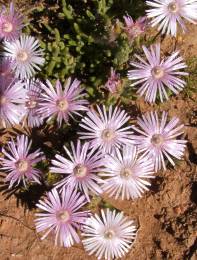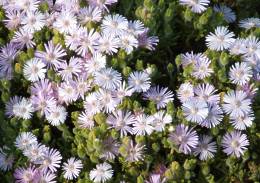Drosanthemum striatum
Drosanthemum striatum (Haw.) Schwantes
Family: Aizoaceae
Common names: ice plant (Eng.); bergygie, vleisbos, porseleinbos (Afr.)
Introduction
An attractive hardy pink perennial vygie, ideal for most garden situations.

Description
Description
A fast-growing, sprawling, succulent perennial with a semi-prostrate, mat-forming growth habit. Drosanthemum striatum only lives for about five years under normal garden conditions.

Plants can grow to 250 mm in height. Stems are covered in glistening papillae (hairs), hence their common name ice plant. Leaves are sub-cylindrical (not quite round), obtuse (blunt or with rounded tip) and 20-25 mm in length. The leaf stalk (petiole) is short, and flower petals are white, silver-pink or deep pink. Each petal is marked with a central stripe. Flowers are 20-30 mm in diameter and appear from late August to late September. Seed is produced in a woody capsule and seed matures in late January.
Conservation Status
Status
Drosanthemum striatum is considered Vulnerable (Raimondo et al. 2009). Only ten natural populations remain in the wild; populations are declining mainly due to the expansion of wheatlands, vineyards and olive orchards.
Distribution and habitat
Distribution description
Drosanthemum striatum is endemic to the southern part of the Western Cape. It occurs naturally in Malmesbury shale in lowland renosterveld.
Derivation of name and historical aspects
History
The genus Drosanthemum is derived from the Greek drosos which refers to the glistening bladder cells on the leaves which look like dew drops, and anthos which means flower. The specific epithet striatum is from the Latin, meaning striped and refers to the line which runs down through the middle of the petal.
Drosanthemum is a fairly large genus with nearly 70 species, occurring mainly in the winter-rainfall areas of southern Africa. Most Drosanthemum species have showy conspicuous flowers which attract suitable pollinators.
Ecology
Ecology
Pollinators are essentially moths and bees. Drosanthemum striatum flowers after 11 am in the morning and on into the evening. It is likely that moths pollinate the flowers after 5 pm.
Uses
Use
Horticulturally, Drosanthemum striatum is very versatile and is an attractive feature in most garden situations. Apart from doing well in arid regions where water is scarce, it also does well in Cape Town gardens, even during relatively wet winters.
Drosanthemum striatum is suitable for both full-sun and semi-shade conditions, possibly one of the only mesembs that actually flowers well in both. It grows very rapidly from young seedlings and, if planted in April, will flower by September of the same year.

Growing Drosanthemum striatum
Grow
This mesemb is relatively hardy, tolerating mild frost (-2°C). It tolerates dry, hot summer temperatures of 40°C and above. It can be grown successfully in most gardens in the Western Cape and in other parts of South Africa, but not in areas of high summer rainfall and in subtropical areas.
Drosanthemum striatum is cultivated mostly from seed. Copious amounts of seed are produced after flowering, normally around late January. Seeds are light brown and each seed is about the size of a pin head.
Seed should be sown in late autumn (May). Sow the seeds in open, flat seed pans using a well drained loamy soil mixture. Ensure that seeds are not sown too thickly otherwise they may damp off (rot) when they germinate. Firm the seeds down with a piece of flat board and cover the seeds with a layer of sieved river sand.
Keep the seed pans in a well-ventilated area where there is good light. Water with a fine spray-head. If conditions are warm and windy, it may be necessary to water on a daily basis. Water earlier in the day than than the end of the day. The reason for this is that humidity increases as nightfall approaches thus increasing the risk of damping off.
When the seedlings are 50 mm or higher, transplant them either into half-litre plastic bags or small plastic containers. Keep them in a semi-protected location at first until they are sufficiently hardened off. They may then be moved outside. It is recommended that they have at least three weeks to harden off completely.
To grow from cuttings treat the material with a rooting hormone prior to striking in a growing medium. Ideal rooting mediums are essentially 50% washed, sieved river sand, 25% perlite and 25% vermiculite. Good drainage is the key to good rooting.
The ideal time to root these cuttings would be in May or June (southern hemisphere). Once roots have formed, normally from the nodes (where buds come from), transplant into light loamy soils, harden off for three weeks and move to an outside location prior to planting.
References
- Court, D. 1981. Succulent flora of southern Africa. Balkema, Cape Town.
- Raimondo, D., Von Staden, L., Foden, W., Victor, J.E., Helme, N.A., Turner, R.C., Kamundi, D.A. & Manyama, P.A. (eds). 2009. Red List of South African plants. Strelitzia 25. South African National Biodiversity Institute, Pretoria.
- Van Jaarsveld, E.J. & De Villiers-Pienaar, U. 2000. Vygies gems of the veld. Grafica Quadro, Tradate (VA), Italy.
Credits
Ian Oliver
Karoo Desert National Botanical Garden
January 2011
Plant Attributes:
Plant Type: Perennial, Succulent
SA Distribution: Western Cape
Soil type: Sandy, Loam
Flowering season: Spring
PH: Acid, Neutral
Flower colour: Pink
Aspect: Full Sun
Gardening skill: Average
Special Features:
Horticultural zones









Rate this article
Article well written and informative
Rate this plant
Is this an interesting plant?
Login to add your Comment
Back to topNot registered yet? Click here to register.